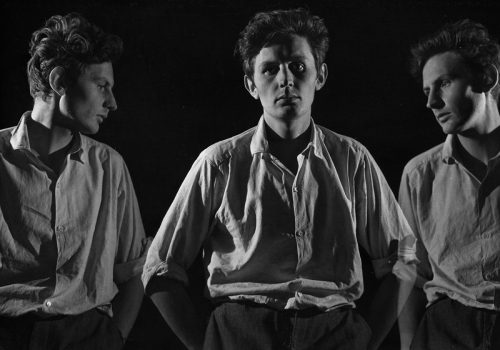During his first years of photographic work, 1955-1960, before entering the world of advertising and fashion, Jean-François Bauret devoted himself to research that referred to his intimate world and his aesthetic choices.
He then produced numerous reports with great artists of the time, gathered in around thirty albums and at the same time created images for which he made the prints himself, often only a single copy.
These are still lifes, photograms giving rise to abstract or plant compositions and very often nudes for which his wife is the model.
In 1962, he moved to Paris and opened his studio, driven by demand in the field of advertising and fashion, however, saving a lot of time to engage in his personal research.
His advertising campaigns were often very noticed: the famous “naked man” of Sélimaille, a brand of male underwear (1967), caused a real event at the time, scandalous as well as liberating.
A few years later, he broke the taboo of the image of the pregnant woman by taking a photograph for Materna of a naked little girl and her pregnant mother.
The portrait and the nude occupy a preponderant place in his work, throughout his life, without being necessarily differentiated in one or another of his representations, his research is based on his personal philosophy summarized in two words, “to be and to appear”.
He seeks the representation of “being” by all means, both plastic and psychological.
These nudes are in reality portraits, “with these images I wanted to portray the individual as he is, without expression or feeling, in a raw state, without the effect of light, decoration, clothing. . Without optical or color effect. Nudity is the absence of clothing and has nothing to do with eroticism or exhibitionism. ”
The image of the woman in all its raw realism, and not just thin, young and pretty, contrasts with the usual portrayal of models used in advertising. Like Man Ray, of whom he was a fervent admirer, his commissioned work joins his personal research: always stripped down, his compositions show bodies without ornamentation, in a direct way.
This is how the portrait and the nude occupy a preponderant place in his work, throughout his life, without being necessarily differentiated, in both of his representations, his research is based on his personal philosophy of the representation of the human being, which can be summed up in two words, “being and appearing”.
He seeks the representation of “being” by all means, rejecting what seems uninteresting to him, “appearing”.
These nudes are in reality portraits, “with these images I wanted to portray the individual as he is, without expression or feeling, in the raw state, without the effect of light, decoration, clothing. Without optical or color effect. Nudity is the absence of clothing and has nothing to do with eroticism or exhibitionism.”
The image of the woman in all its raw realism, and not just thin, young and pretty, contrasts with the usual portrayal of models used in advertising. Like Man Ray, of whom he is a fervent admirer, his commissioned work joins his personal research: always stripped down, his compositions show bodies without ornamentation, in a direct way.
Subsequently, he continued to conduct personal studio research on various forms of representation of the body. The sometimes daring choreography of the movements is underlined by a stripped back background and lighting.
His monograph published in 2018 by Contre-Jour editions gives a very good account of this long journey, both classic and modern.
Jean-François Bauret
December 2, 2020 – February 2, 2021
RCM Galerie
32, rue de Lille, 75007 Paris
















